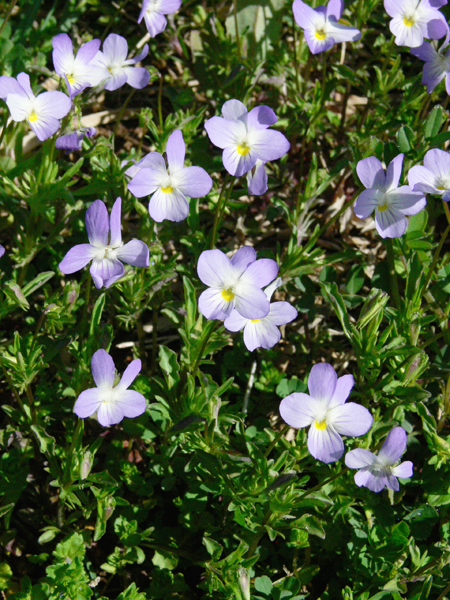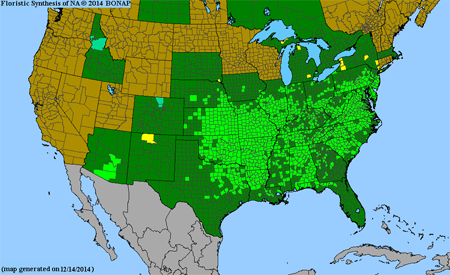Viola rafinesquei Greene
Common names:
Field Pansy, Wild Pansy
Synonyms:
Viola rafinesquei Greene, Pittonia 4: 9. 1899 [replacement name for V. bicolor Pursh]; Viola kitaibeliana Schult. var. rafinesquii (Greene) Fernald, Rhodora 40: 443. 1938; Mnemion rafinesquii (Greene) Nieuwl., Amer. Midl. Naturalist 3: 217. 1914; Viola bicolor Pursh, Fl. Amer. sept. 1: 175. 1813 [illegimate homonym of Viola bicolor Hoffm. (1804)]. TYPE: U.S.A. [Pennsylvania, Cumberland Co.: Carlisle], Connedagwinit Cave [now Conodoguinet Cave, at Cave Hill Park and Nature Center], [s. d.], [F. Pursh s.n.] (LECTOTYPE (designated by Ballard et al. 2020. Journal of the Botanical Research Institute of Texas 14(2): 225): K (K000651424, internet image!)]
Viola rafinesquii Greene f. caerula Moldenke, Phytologia 26(4): 225. 1973
Viola rafinesquii Greene f. minor Moldenke, Phytologia 26(4): 226. 1973
Description:
Caulescent annuals from slender taproot, stems erect, solitary, ≤ 27 cm tall; stems, foliage and peduncles green, quadrate stems recurved-puberulent or -hispidulous on face directly above a leaf node but essentially glabrous on the other faces, leaves glabrous or occasionally sparsely hirtellous along veins, peduncles glabrous; leaves cauline, distributed along stem; stipules free, deeply palmately to subpinnately lobed, terminal lobe oblanceolate, slightly larger than lateral lobes, similar in shape, with 0–3 crenations per margin; leaves ascending, leaf blades undivided, upper ≤ 24 × 6 mm (including indistinguishable petiole), oblanceolate or obspatulate to obovate, base narrowly cuneate and decurrent onto indistinct petiole, lower ≤ 14 × 11 mm, broadly oblong-ovate to orbicular or subreniform, subcordate and distinct from petiole, margins entire or inconspicuously crenate or serrate on each side, appressed-ciliate to eciliate, apex obtuse to broadly rounded; chasmogamous flower ≤ 14 mm, petals much longer than sepals; calyx glabrous, densely ciliate; lowest sepals broadly lanceolate to ovate-lanceolate, sharply acute; auricles prominent, entire or erose, not elongating in fruit; corolla commonly pale blue, infrequently white, throat yellow; spur short, thick, slightly extending beyond auricles; lateral petals densely bearded with narrowly linear to slightly clavate hairs, spurred petal glabrous; cleistogamous flowers produced after chasmogamous; capsule 3.5–6 mm, green drying tan, unspotted, glabrous; seeds 1.2–1.5 × 0.6–0.9 mm, tan to golden orange or lighter red-brown, unspotted; 2n=34.
Similar species:
This species is quite easily distinguished from the two widely distributed, introduced pansy species, V. arvensis and V. tricolor, in the absence of basal leaves, its commonly uninformly pale blue corolla and yellow throat, stipules with the terminal lobe slightly larger than but similar in shape to the lateral lobes and with margins entire or with up to 3 crenations per side, and leaf blade short and rather quadrate with margins entire or with up to 2 shallow crenations per side. It differs further from V. arvensis in the petals well surpassing the sepals, a trait it shares with V. tricolor.
Ecology:
Noticeably calciphilic, floodplains, alvars and other open natural sites, also dry rocky woods and barrens; somewhat weedy (like other pansies) and extending along trails, roadsides, pastures and lawns.
Distribution:
Widespread in e. North America and sporadic in the Southwest, ME to se. SD, south to FL and AZ, disjunct in ID and SK.
Rarity:
State listed in NY.
Phenology:
Chasmogamous flower Feb–May, chasmogamous fruit March–May, cleistogamous fruit May–June.
Affinities:
This species belongs to the Pansy lineage, sect. Melanium Ging., subsect. Cleistogamae Marcussen & Danihelka
Hybrids:
None.
Comments:
Pursh provided the brief and generalized statement, “In fields of Pensylvania and Virginia,” in his protologue, but he cited no specific collections or types. According to Stafleu and Cowan (1983), Pursh’s herbarium was distributed to a number of institutions including BM, K, OXF, and PH. Besides the Pennsylvania specimen designated as the lectotype by Ballard et al. (2020), two Maryland specimens are likely duplicates and probably constitute original material: U.S.A. [Maryland]. Antietam, Wet ground, similar to the one from Carlisle Cave, 1806, [F.] P.[ursh s. n.] (PH00039358, internet image!); and U.S.A. [Maryland]. Antietam, [no date], [F. Pursh s. n.] (K00032789, internet image!). Early in the last century, the name V. bicolor Gilib. (Fl. Lit. Inch. 2: 123. 1782) was believed to invalidate the later use of the name by Pursh (Fl. Amer. Sept. 1: 175. 1813), and the use of Greene's replacement name V. rafinesquii came into vogue. Later, the International Botanical Congress placed Gilibert's publication on the list of sanctioned works, leading to rejection of the name V. bicolor Gilib. and allowing for application of the name V. bicolor Pursh for the present species. An earlier validly published use of the name Viola bicolor by Hoffman in 1804, predating V. bicolor Pursh, was recently brought to light by my friend, colleague and violet specialist Thomas Marcussen (pers. comm.) for a European violet, forcing us to return to the next available name, V. rafinesquei Greene for our Wild Pansy. Alan Weakley (pers. comm.) pointed out the correct spelling of the specific epithet.
Brainerd (1921b), Brainerd Baird (1942), Alexander (1963), Russell (1965), Strausbaugh and Core (1978), and Gleason and Cronquist (1991) recognized the present taxon as a distinct species under the name V. rafinesquii Greene, while Ballard (2000, 2013), McKinney and Russell (2002), Weakey et al. (2012), and Little and McKinney (2015) did so under the name V. bicolor Pursh. Fernald (1950), Henry (1953a), and Swink and Wilhelm (1979) treated it as V. kitaibeliana Shult. var. rafinesquii (Greene) Fernald, and Scoggan simply synonymized it under V. kitaibeliana Shult. without recognition.
The nativity of this species has been the subject of debate. Fernald (1938) made an empassioned argument for the present species as an introduction from Europe and as conspecific with Old World V. kitaibeliana Schult. He based his arguments on ubiquity of the present taxon in disturbed sites and virtual (to him) morphological identity with V. kitaibeliana (he compared photographs of North American wild pansy with Old World specimens. In rebuttal, Clausen et al. (1964) provided an equally compelling set of arguments for native status in North America. While seemingly compelling, Fernald's arguments are all countered by equally convincing and more modern evidence supporting native status. This is the only species in Sect. Melanium to evolve cleistogamous reproduction, it differs morphologically from V. kitaibeliana in a number of traits in the leaves and chasmogamous flowers (none of Fernald's material from Europe matches the type and other confirmed specimens of V. kitaibeliana), it possesses a different chromosome number, and in unpublished molecular phylogenies it falls out in a basal position to the rest of the section. Moreover, it favors native habitats such as alkaline floodplains in which the natural disturbance regime promotes weediness, just like other fully accepted natives such as Acer negundo, Packera aurea, Pilea pumila and Viola striata. The overwhelming preponderance of evidence is in favor of native status. This is the only indigenous (although sometimes weedy) New World pansy in an otherwise Eurasian lineage, Sect. Melanium. Given its several divergent features from other members of the section, it was recently placed in subsect. Cleistogamae as the sole member (Marcussen et al. 2022).
Literature Cited:
Alexander, E. J. 1963. Violaceae. In Gleason, H. A., The new Britton and Brown illustrated flora of the northeastern United States and adjacent Canada. Hafner Publishing Co., Inc., New York, NY. 552-567.
Ballard Jr., H. E. 2000. Violaceae. In Rhoads, A. (ed.). Flora of Pennsylvania. University of Pennsylvania Press, Philadelphia, PA. 700-710.
Ballard Jr., H. E. 2013. Violaceae. In Yatskievych, G., Flora of Missouri. Missouri Botanical Garden Press, St. Louis, MO. 1218-1243.
Brainerd, E. 1921b. Violets of North America. Vermont Agricultural Experiment Station Bulletin 224: 1-172.
Brainerd Baird, V. 1942. Wild violets of North America. University of California Press, Berkeley, CA.
Fernald, M. L. 1938. Contributions from the Gray Herbarium of Harvard University–No. CXXIII: Noteworthy plants of southeastern Virginia. Rhodora 40: 364-424, 434-459, 467-485.
Fernald, M. L. 1950. Violaceae. In Gray’s Manual of Botany, 8th ed. American Book Company, New York, NY. 1022-1042.
Clausen, J., R. B. Channell, and U. Nur. 1964. Viola rafinesquii, the only Melanium violet native to North America. Rhodora 66: 32-46.
Gleason, H. A., and A. Cronquist. 1991. Violaceae. In Manual of vascular plants of northeastern United States and adjacent Canada, 2nd ed. New York Botanical Garden, Bronx, NY. 157-163.
Haines, A., E. Farnsworth, and G. Morrison. 2011. Violaceae. In Flora Novae Angliae. Yale University Press, New Haven, CT. 873-886.
Henry, L. K. 1953a. The Violaceae in western Pennsylvania. Castanea 18(2): 37-59.
Little, R. J., and L. E. McKinney. 2015. Violaceae. In Flora of North America: Cucurbitaceae to Droseraceae, 106. Oxford University Press, New York, NY.
McKinney, L. E., and N. H. Russell. 2002. Violaceae of the southeastern United States. Castanea 67: 369-379.
Russell, N. H. 1965. Violets (Viola) of the central and eastern United States: An introductory survey. Sida 2: 1-113.
Scoggan, H. J. 1978. Violaceae. In Flora of Canada, Part 3–Dicotyledoneae (Saururaceae to Violaceae). National Museums of Canada. Ottawa, Canada. 1103-1115.
Stafleu, F. A., & R. S. Cowan. 1983. Taxonomic literature: a selective guide to botanical publications and collections with dates, commentaries and types, 2nd ed., vol. 4: P-Sak. Bohn, Scheltema & Holkema, Utrecht, The Netherlands. [https://www.sil.si.edu/DigitalCollections/tl-2/]
Strausbaugh, P. D., and E. L. Core. 1978. Violaceae. In Flora of West Virginia, 2nd ed. Seneca Books, Inc., Morgantown, WV. 644-658.
Swink, F., and G. Wilhelm. 1979. Violaceae. In Plants of the Chicago region, 2nd ed. revised and expanded. Morton Arboretum, Lisle, IL. 384, 801-810.
Weakley, A. S., J. C. Ludwig, and J. F. Townsend. 2012. Violaceae. In Flora of Virginia. BRIT Press, Fort Worth, TX. 963-975.

Chasmogamous flowering habit by Andrew Gibson, "Buckeye Botanist" website

Chasmogamous flowering habit by Bruce Sorrie

Chasmogamous flower front view by D. Busemeyer, "SERNEC portal" website

Seeds from herbarium specimen: OH, 28 Apr 1984, P. Lewis 1836 (OS422620)

Map by the Biota of North America Program